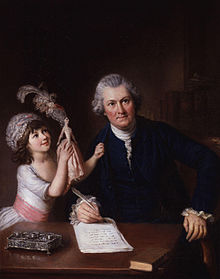Christopher Anstey
| Christopher Anstey | |
|---|---|

Anstey with his daughter,
by William Hoare (c. 1777) |
|
| Born | 31 October 1724 Brinkley, Cambridgeshire |
| Died | 3 August 1805 (aged 80) Bath, Somerset |
| Nationality | English |
| Occupation | writer, poet |
| Notable work | The New Bath Guide (1766) |
Christopher Anstey (31 October 1724 – 3 August 1805) was an English poet who also wrote in Latin. His New Bath Guide began an easy satirical fashion that was influential in the second half of the 18th century.
Anstey was the son of the Rev. Dr. Christopher Anstey, the rector of Brinkley in Cambridgeshire, where he was born on 31 October 1724. He was educated at Eton College and King's College, Cambridge, where he distinguished himself for his Latin verses. He became a fellow of his college in 1745 but the degree of M.A. was withheld from him in 1749 owing to his defiance of the university authorities and the offense caused by an address that is said to have begun "Doctors without doctrine, artless masters of arts, and bachelors more worthy of the rod than the laurel..."
In 1754, having succeeded to the prosperous family estates (including Anstey Hall in Trumpington), he withdrew from the university. Two years later, he married Ann, the sister of his friend John Calvert of Albury Hall, Hertfordshire. For a considerable time Anstey lived the life of a country squire, cultivating letters as well as his estates, but publishing little of any note for many years. His family grew to include thirteen children, eight of whom survived him.
Following a period of depression aggravated by ill health after the death of a beloved sister in 1760, he was advised to take the waters at the fashionable spa of Bath. Impressed by the place, he returned annually and decided to settle there permanently in 1770, his home being at No. 4 Royal Crescent for the next thirty-five years. In 1766, he achieved fame following the publication of The New Bath Guide: or Memoirs of the B__n__r__d Family in a series of Poetical Epistles, which went through some twenty editions before 1800. The work was enthusiastically praised for its gently satirical humour by such literary figures as Horace Walpole and Thomas Gray.
...
Wikipedia
